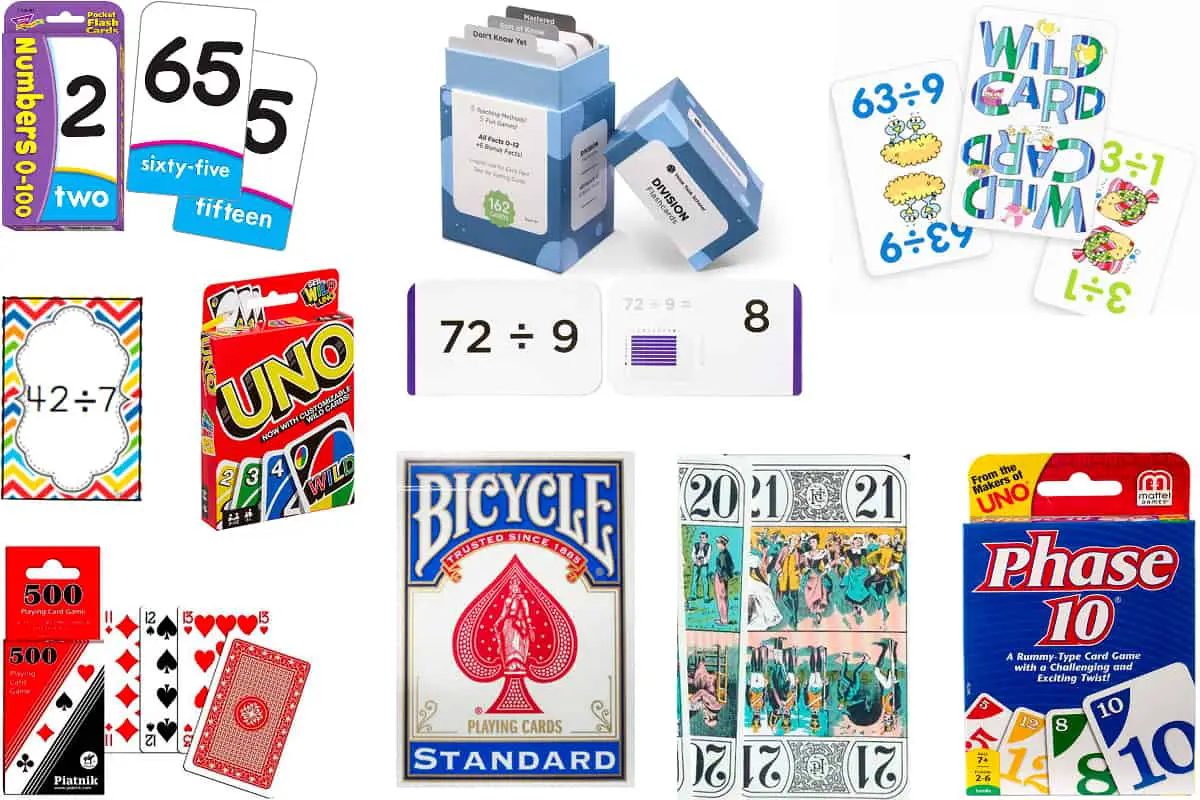This post contains affiliate links.
I was recently asked by a teacher what the best division card games are, and I could not really find an answer. So, I did some research and tests to determine which are ranked as the best for schools and at home play!
I found over 20 division card games, including variations of classic games (War, Old Maid, Go Fish, etc.), positioned them according to CCSS, staged different scenarios and added some personal advice. The best game for you depends on several factors:
- stage in teaching divisions (CCSS standard)
- scenarios: at home/at school, with/without an adult, number & level of players (same level/age or not)
- using standard or dedicated cards, budget, etc.
This post starts with tables to show division games that I recommend as per:
- scenario (at school or at home, number of players, types of players)
- CCSS (Common Core State Standards) competence being practiced (whole or decimal number division, type of division problem, etc.).
I hope this can help you quickly pinpoint the right games for you. In the rest of the post, you will find the complete list of games that I have identified and sorted by game type:
- rules using standard card decks, UNO or tarot card decks (yes, they can be very useful!)
- games using purpose-designed cards
- printables, and even free printables!
Each game or rule goes along with explanations about why I would or would not recommend them. For games that use standard decks, I have also included the rule itself, or links to where you can find it.
This is a pretty long post, so I thought it would be useful to include a table of contents here:
Table of contents
- Division games according to scenario
- Division card games and CCSS
- Division games that use standard card decks
- Playing divisions games with other available card decks
- Manufactured educational division card games
- Downloadable PDFs proposing rules with standard playing cards
- Downloadable PDF division card games
Division Games As Per Scenario Comparison table
This table shows division games that I recommend as per a typical game scenario:
| Scenario | Features | Suitable Games |
|---|---|---|
| Child playing at home with an adult. | Two players. Adult lets child win. Competitive games OK. Adult supervision. | Div. flashcards Division war Div. war facts (competitive) Divisibility war Division go fish Give some % Division dog |
| Children of different ages play together at home. | Non-competitive. Adult intervention possible. | Division war Div. war facts (collaborative) Div. war compare Divisibility rules Family reunion Div. facts war Goofy gorilla |
| All classroom students play. | Autonomous players. Not too noisy. Groups of 3-4. Winning not linked to skill speed*. | Division war Div. war facts (collaborative) Div. war compare Give some %** Family reunion Div. facts war Goofy gorilla |
| Math centers (school). | Gamified activities. Autonomous players. 1-2 players. | Div. flashcards Div. war compare Divisibility war Divisibility rules Division draw Boom! |
| Teacher plays with all students. | Whole class game. Large size cards. | × and ÷ quizmo I have who has? |
* Except if similar skill groups, i.e., - Players separated into two or more teams (partner games) - Strategic game (winner determined by strategy, not school skill) - Cooperative game (everyone wins if a specific goal is reached) - Winner determined by chance, not skill
** Same skill groups
Division Card Games CCSS Based Comparison Table
| Competence | CCSS* | Relevant Games |
|---|---|---|
| Find “?” in: 48 ÷ ? = 8. Relationship between × and ÷. Equivalence of ? = 32 ÷ 8 and 32 = 8 × ?. | 3.OA.A.4 3.OA.B.6 | Div. war facts (generic cards) |
| Fluently divide within 100. Use properties of operations. Relationship between × and ÷. Memorize 1-9 times tables. | 3.OA.C.7 | Div. war facts Div. war compare Division go fish Div. flash cards Division war Division dog Family reunion Div. facts war Goofy gorilla Boom! × and ÷ quizmo I have who has? |
| Factors & multiples. For 1-100 numbers: – factor pairs – 2-9 divisibility – prime or not. | 4.OA.A.4 | Divisibility war Divisibility rules |
| Understand place value system. Decimal point when ÷ by power of 10. | 5.NBT.A.1 5.NBT.A.2 | Give some % |
* Here only CCSS codes that can be practiced with existing card games (for learning division) are listed.
Now, let’s give you more details about those games!
To make matters clearer, I classified them according to type:
- games using standard cards (that is: rules that you can use with generally available playing cards)
- printable downloadable games (free or not)
- educational division card games (for sale).
6 Division Card Games that Use Standard Playing Card Decks
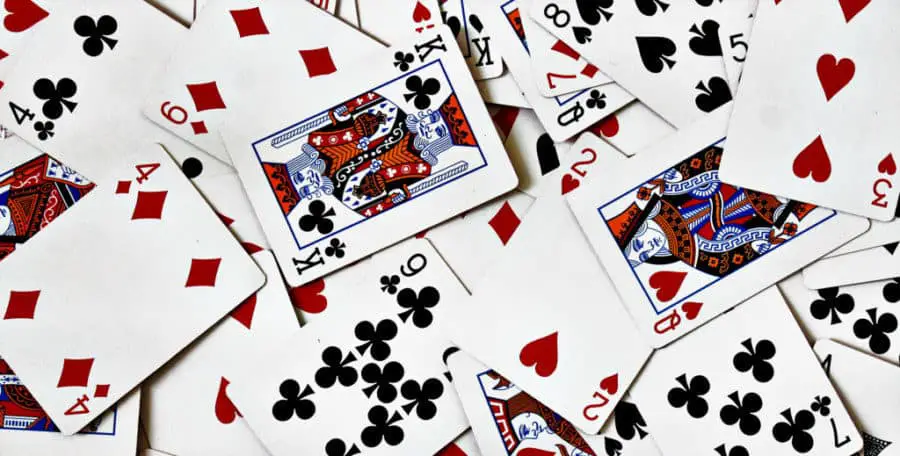
The cheapest, surefire option available to play math games is simply with a standard deck of playing cards! In fact, you probably already have some at home. If you are a teacher, parents will often donate cards if needed, or you can find some in good condition at thrift stores as well!
Standard deck cards are comprised of 54 cards:
- 4 sets of cards from 2 to 10 (in 4 suits or “colors:” diamonds, hearts, spades, clubs)
- 4 Face cards: Ace, Jack, Queen, King
- 2 Jokers.
In order to have 1’s in the game, and deal with numbers larger than 10, you can decide that: Ace represents “1,” Jack is “11,” Queen is “12,” King is “13,” or any other numbers you want, according to the game.
Now, what division game rules can you use with standard card decks?
Division War Facts (competitive)
This is a variation of the classic game of war, but using division. It is suitable for scenarios where a student plays with an adult (which is often the case at home, or when working with a speech therapist), or when the players have comparable levels (the competition is fair, no player is likely to be discouraged).
| Players | 2 or more |
| Skill | Whole division with or without remainders. |
| Card values | Ace represents the number “1,” Jack is “12,” Queen is “14,” King is “15,” Joker is “16”. Other cards stand for their face values (you might want to put a reminder of these values on the table). |
| Objective | Win the largest number of cards. |
| Preparation | Deal all the cards to the players. They form a stack, face down. |
| How to play | On a “ready, set, go!” count, each player turns over two cards (with 2 or 3 players) or one card (4 or more players). The first player who identifies a division fact with the cards on the table can take all the cards and put them under their stack of cards. A division fact is a set of three cards that form a division equation. For instance, a player sees a 10, 5 and a 2 and says: “10 divided by 5 equals 2!”. If no player identifies a division, all players turn over new cards. |
| End of game | The game is finished once one of the players does not have any cards left. The player with the largest number of cards wins; this can take quite a long time with two players, so in this case, you might prefer not to enable players to reuse already won cards. |
Division War Facts (collaborative)
This variation is more suitable for school, where you want the less competitive students to have equal chances of winning as more advanced students, so as not to discourage them.
The rule is the same as the last one, except that players take turns to put cards on the table. When it is a player’s turn, he puts one card on the table and can check if this new number can divide with the existing numbers on the table. If another player finds the division, he/she can say it, however, the winner of the cards is always the original player.
Both division war variations can be played, allowing remainders or not allowing them. If allowing remainders, the players who identify a division with them can assemble 4 cards, i.e., “14 = 6 divided by 2 plus 2.”
Division War Compare
This game is very interesting because it enables players to practice divisions with decimal results (as well as division facts).
| Players | 2 or more |
| Skill | Divisions between whole numbers (with remainder) between 1 and 13. Division between whole numbers (the result being a decimal number). |
| Card values | Ace represents “1,” Jack is “11,” Queen is “12,” King is “13,” Joker is “14”. |
| Objective | Win the largest number of cards. |
| Preparation | Distribute all the cards to the players. Each of them holds his/her stack in hand, face down. |
| How to play | Each round, all players flip over the top two cards of their stack. Each player divides the numbers on their two cards (largest by smallest) and says the result. The player with the largest result wins all cards on the table: – With whole results, the result of the division is the quotient of the division. – With decimal results, the result of the division is the result of the division with two decimals. If two players have the same largest number, the cards remain on the table and each player flips two cards again. |
| End of game | The game ends when a player does not have any more cards. The winner is the player with the most cards. |
“Two-digit War” variation: each player flips three cards. The first two cards are the two digits of the first number; the third card the second number. In this variation, the “face cards” and the “10s” are not used, only the ace “1” and the numbers from “2 to 9.”
Divisibility War
This is a great game to practice divisibility rules with children. It is inspired by the educator’s room. I made some changes to Lori Rice‘s rule to make it a bit simpler but you can see that the principle is the same.
| Players | 2 to 4 players |
| Skill | Divisibility rules by one-digit numbers. |
| Card values | Ace represents “1,” Joker and face cards are “0.” |
| Objective | Win the most cards. |
| Preparation | Use 2 decks of cards with two different backs, in order to easily differentiate them: – The first deck will be to play war – The second for each player to record divisibility Remove tens. Deal the cards of the first deck to the players (each one has a stack face down). Give one color of the second deck to each player (spades, clubs, diamonds or hearts). |
| How to play | Each player: – Flips over four cards (from the first deck’s cards), and lays them on their left next to the other without changing the order, drawing a four-digit number. – Puts on the right of this number the cards (from the second deck) that represent the numbers it is divisible by. The player who has a number that is divisible by the most numbers wins all cards. In case of a tie, the players play another set of cards (the winner takes all). |
| End of game | The game ends when one player does not have any more cards. The player with the most cards wins. |
Division Go Fish
Go Fish is a very popular game, usually best suitable for younger children, as it can be a bit slow and unexciting for older children.
When first learning division, it takes time to comprehend, so having a “slow” game mechanism is not a problem. Once children automate their division facts though, the objective changes to be memorize facts as fast as possible; I advise choosing faster, more intensive rules, such as War or Old Maid.
| Players | 2 or more |
| Skill | Divisions between whole numbers with a result (without remainder) between 1 and 10 |
| Objective | Win as many matchings as possible. |
| Preparation | Keep only the cards between 1-10. Deal 6 cards to each player. Place the remaining cards in the middle as a draw pile. |
| How to play | Players then take turns. At his/her turn, the player says, i.e., “Do you have 12 divided by 3?” to one of the other players – The player who is asked must give the result (“4” in this example) if he/she has it. – Then the current player puts the matching card (the “4”) on the table beside him/her. Else, the current player draws a card from the pile. |
| End of game | When a player runs out of cards, or the pile is gone, the game ends. The player with the most matching cards wins the game. |
Give Some Percent
This game comes from PEP’s Acing Maths’s PDF, page 59 (a free download, do not hesitate to download it yourself).
Skill: Divisions of numbers 1 to 14 by a given percentage (leading to results of divisions that are decimal numbers).
It is a basic game that makes practicing calculation of percentages (which involve a division) more fun. It should be played with players of comparable levels, or the fastest will always win (a very competitive game where only the capacity to calculate determines who wins).
6 Card Games You Can Use To Teach Divisions
There are several available card games that essentially are comprised of numbers and lend themselves to making division card games just like (or better than) standard playing games.
UNO Cards

UNO card decks are really practical because they have 8 copies of each number from 1 to 9 (and 4 Zeros); one UNO card deck has twice as many numbers as a regular playing card deck. They are cheap (mass-produced by Mattel).
UNO cards are also very colorful and many children know and like them. They can be used instead of standard playing cards in the games mentioned before (Division War, Go Fish). Another advantage is that they have many special cards, that you can use to create variations of your rules.
“500” Cards

Lesser known “500” games decks have the same cards as standard playing cards, except that the face cards are replaced by cards with numbers up to 13. They are cheap, as “500” is a renowned game and is mass-produced by the Bicycle brand and Piatnik. So, if you do not want to tell children that “Jack = 11,” “Queen = 12,” “King = 13,” try a deck of “500” cards.
have the same cards as standard playing cards, except that the face cards are replaced by cards with numbers up to 13. They are cheap, as “500” is a renowned game and is mass-produced by the Bicycle brand and Piatnik. So, if you do not want to tell children that “Jack = 11,” “Queen = 12,” “King = 13,” try a deck of “500” cards.
There is also a card deck by “Learning Advantage” that comes with numbers up to 13 and is specially made for education purposes.
Phase 10 Cards
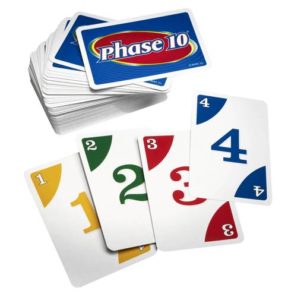
Phase 10 game’s cards are also practical because they have numbers up to 12. They are sold by Mattel and are cheap. Phase 10 card decks are comprised of 108 cards:
are also practical because they have numbers up to 12. They are sold by Mattel and are cheap. Phase 10 card decks are comprised of 108 cards:
- 96 numbered cards: two of each value from 1 through 12, in four colors
- 8 Wild cards & 4 Skip cards.
French Tarot Cards
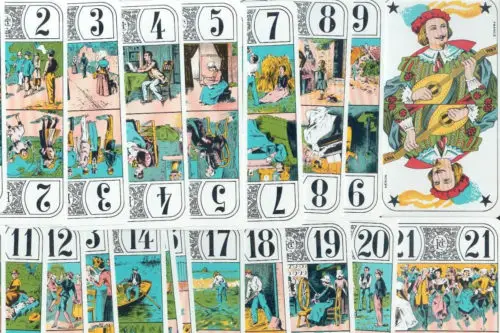
I love these cards. French tarot decks (for tarot game playing, not the ones for cartomancy) comprise the following 78 cards:
- In the 4 “colors” (spades, hearts, diamonds, clubs):
- The numbers from 1 to 10 (40 cards)
- Jacks, Riders, Queens, and Kings
- 21 numbers (decorated) from 1 to 21
- 1 un-numbered card called “Excuse”
They are beautiful and interesting for math games because:
- The numbers go up to 21.
- They are cheap if you happen to buy them in France.
- Jacks, Riders, Queens, and Kings can be used to stand for numbers that have many divisors such as 12 (Jacks), 16 (Riders), 18 (Queens), 20 (Kings), 24 (Jokers). This allows finding divisions more easily during the game. You might want to use a sticker on these cards with their value (or write down the values on a paper put on the table) to facilitate their use.
French Tarot cards can be used to play:
- Division War facts described before the same way as with usual playing cards. You can play until 24 rather than 15, which is great.
- Give some percent, making the game more difficult up to 24.
- Division war compare with numbers up to 24 – and you can make the difficulty gradual by including the higher numbers progressively.
You can find tarot cards deck on Amazon (shipping from Amazon’s global UK store) from Piatnik or Ducale
or Ducale (Asterix themed, making them even more fun).
(Asterix themed, making them even more fun).
0-100 Playing Cards

There are also available card decks with numbers from 0 to 100 that can be practical for creating division card games:
- Numbers 0-100 Pocket Flash Cards
 (Tend Enterprises) – the deck comprises 100 cards numbered from 1 to 100.
(Tend Enterprises) – the deck comprises 100 cards numbered from 1 to 100. - Wipe clean number playing cards
 0-100.
0-100.
With 0-100 playing cards, you can play:
- Divisibility war: You will draw just one card to determine the divisor number you are looking for (instead of two – one for each digit). The advantage is the possibility to start with smaller numbers by sorting the cards.
- Give some percent, making the game more difficult (and you can increase the difficulty gradually by sorting the cards to be used).
- Division war compare: the two-digit variation.
- Division war facts up to 100!
5 Purpose Built Educational Division Card Games
Not so many publishers actually propose educational card games for practicing divisions. Note that games devised to work multiplication tables can sometimes be tweaked to work on divisions – I will not cover them though. So here are the games that:
- Have at least one rule that enables to specifically practice divisions (not the four operations).
- Are real card games (not just flashcards without any rules).
Division Flash Cards (Think Tank Scholar)
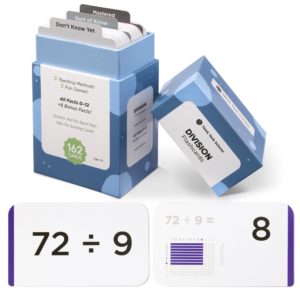
These are in my opinion the best flashcards available for learning whole divisions without remainder. There are 2 “real” game rules:
available for learning whole divisions without remainder. There are 2 “real” game rules:
- War is perfect at school as it is not competitive (the winner is purely determined by luck), and the game is not “noisy”.
- Slapjack is perfect at home as it is competitive and noisy but really fun because players have to react quickly.
Besides, the flashcards are the best designed out there in my opinion:
- Very clean visually, nothing gets in the way.
- All division facts for tables up to 12 are covered (162 cards).
- The result on the back of the card is illustrated.
- Tabs enable to sort cards according to the facts that are already known: this is a really good idea.
- The cards have a color-coding by the divisor. You can learn by phases thanks to this.
The only points I do not like that much are the following:
- The cards are really very large
- This is good for the visuals on the back of the cards but slows down the games (children have small hands).
- You will be limited in the creation of new rules because of the size of the cards. For instance, you cannot create a rule where many cards will be put on the table or any rule where the players will hold their cards in their hands in a fan-shaped pattern.
- The graphics on the back are perfect to understand multiplications (arrays of rectangles that represent the multiplication), but not so much for understanding the division that is required. To visualize the division, it might have been better to represent groups of rectangles (for instance, to represent 12÷3, you could show 3 groups of 4 rectangles) – although you could argue that multiplication being the inverse of division, the existing design is fine.
Multiplication and division quizmo (Learning Advantage)
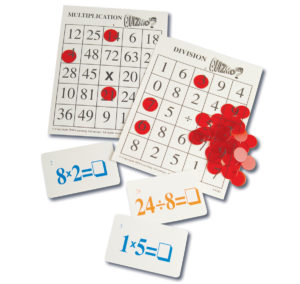
This game is actually a bingo game, but with calling cards that can be used as flashcards.
is actually a bingo game, but with calling cards that can be used as flashcards.
Contrary to “Division Flash Cards,” there is a division on each side of each card (with the answer in small print on the back). The advantage is that you get 200 division facts for 100 cards (but the answer of the division of the back could be confusing for the children, so you have to tell them beforehand not to take this into account).
You also have a version of the game with positive and negative numbers – which in my opinion is not very useful but why not.
Overall I find this game efficient as it can be used both for playing bingo and with “war” or “slapjack” rules.
Division War (Flash Kids)
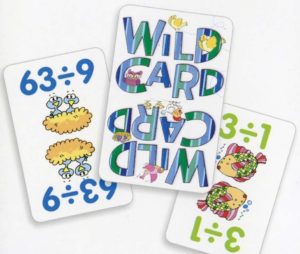
I like this flashcard game because:
because:
- It is really cheap (about 4 times less expensive than the 2 other flash card-based games mentioned just before).
- The War rule works fine – it is a real game.
- The cards are pretty (even if the illustrations are not related to the underlying math facts) which makes them nice to use.
- 86 cards are enough to cover facts from 0 to 10.
So, if you want a cheap division war game to automate division math facts, this game is just what you need in my opinion.
You should be aware though that there is no way to fact check using the cards themselves (no “auto-correction” mechanism), contrary to the two games mentioned before. This is where I think that the game could be even better: the editor could have “encoded” the response to the math fact in the illustration itself (in an intelligent way that would require counting, so that remembering the division fact would actually be faster)! Except this, I find the game really fun and a good value for its price.
Division Flash Cards (Carson Dellosa)
Well, if you want an even cheaper option, you can play the same game of war with this game .
.
The 54 cards are clean but a bit dull. You get two facts per card, one on each side, with the answer in small print on the other side as well. the answer is less likely to confuse children than other similar flashcards because the solution is a complete fact, not just the result.
Most facts for tables 0 to 12 are covered, but not all (about a third of the facts are missing).
Another problem is that the cards have not been designed to handle the progression in the tables. There is no card coding to select parts of the times tables according to the progression of your child (and the cards have the same color on the two sides, which makes sorting according to times tables or to the facts that your child already knows practically impossible). So they are meant for revising and automating your division facts, not really learning them.
If you want to be able to do this kind of sorting, and have all the facts included, you should rather buy “Division Flash Cards” from Think Tank Scholar, which are the best for this purpose, or “Division Wars” from Flash Kids (but they have the facts until 10 only).
Math Stacks (EAI education)
Then what about the “Math Stacks ”? You stack cards that represent the same number. Stacks with 3 cards can be set aside and counted in the end. The player with the most stacks wins.
”? You stack cards that represent the same number. Stacks with 3 cards can be set aside and counted in the end. The player with the most stacks wins.
The principle is simple, but I find that not enough facts are covered (only 60 cards for multiplications AND divisions).
And you can use the same rule with “Division War” from Flash Kids, or with “Division Flash Cards” from Think Tank Scholar. the rule works just fine with them.
Tho Downloadable PDFs Proposing Rules to Learn Divisions with Standard Playing Cards
These PDFs are not too expensive. You will not need to print & laminate the cards: just use standard playing cards.
3rd Grade Multiplication & Division Math Games (Math in Motion)
There are three division related games (the two first are fun activities rather than full-fledged games, but each is really fun) for two players included in this 6 games set :
:
- Fact Family Dash: one of the players “races” to complete multiplication and division facts with dominoes. The other player counts the time spent.
- Inverse Operation Station: the players compete to be the first to complete a multiplication with playing cards on a board. Then they have to make the inverse division.
- Divide and Conquer: the players make whole number divisions without remainder using an array of 25 cards on the table. Each player plays at his/her turn. The strategy is basic so that who the winner is a question of luck and not doing mistakes in one’s divisions, making the game not too competitive and right for the school.
I find these games relevant and simple enough for the school setting they are created for. The rules are really well written (easy to understand, with nothing left to interpretation). Rules and boards are in color as well as black and white for cheaper printing.
Divisibility Rules (Chalk & Apples – Playing Card Games)
There are 30 games in this 60 pages resource spanning additions, multiplications, fractions, decimals, many of which are played with standard playing cards. This is why I included it here although it comprises only one division game.
spanning additions, multiplications, fractions, decimals, many of which are played with standard playing cards. This is why I included it here although it comprises only one division game.
In Divisibility Rules, players draw a card and win it if the number on the table is divisible by this card. So the winner is left to chance (for players who know their divisors), which is a good thing for school (non-competitive rule).
I find this file a really good resource, although the rules are not very clearly explained (some ambiguity, not everything is explained). So you will have to improvise, but the principles described for each rule are sound for the classroom although generally extremely simple (if not overly simple sometimes). So I would consider this file a great source of information for teachers (and parents). Starting from this you can absolutely use your imagination to spice up a bit the rules and make them even more fun.
11 Printable Division Card Games (Downloadable PDFs)
There are many downloadable PDFs that comprise division card games available on “Teachers Pay Teachers” and other platforms, ranging in price from $1 to $15. They are generally cheaper than purpose made educational games but you should take into account the cost and the time of printing them, especially if they are only in full color (no blackline version of the cards).
[FREE] Division Draw, Division Dog, Division Memory (Teresa Evans)
This free file contains 3 division card games (24 games total). Division dog is the most dynamic and challenging and better for home (or students with similar levels).
contains 3 division card games (24 games total). Division dog is the most dynamic and challenging and better for home (or students with similar levels).
- Division Draw is played with a deck of standard playing cards and enables 2 to 5 players to practice division facts. This activity (there is no real interaction between players) is good for math centers for instance (very easy to set up, the winner is the result of pure chance).
- Division Dog is played with special cards from 1 to 9 (could be played with standard cards) and enables to practice basic division facts. It is more calculation-intensive than division draw and is competitive.
- Division memory is a “memory” game played with specific cards (divisions cards and results cards) and enables to practice 24 division facts.
[FREE] It’s a Family Reunion (Classroom “Panda”-monium)
It’s a Family Reunion is fun because of the theme (family & pet characters) and of the mechanism which creates some interaction while letting a large part of the result to chance. I really recommend trying it out to practice division facts differently (divisions without remainders within times tables up to 10).
I have Who has?
There are several downloadable versions of the classical “I Have Wo Has?” for divisions (not really card games). They enable to create an activity, for example between teaching sessions, to lighten the atmosphere while still doing some work.
I mention them in this article because these free downloadables shows how you can create this kind of game for your classroom to practice division facts.
- By Krista Mehrtens
 (free resource)
(free resource) - By SuperTeachersworksheets
 (free resource)
(free resource) - Division I Have… Who Has…?
I would not advise using directly one of the two first though because the letters on the cards give a hint to students (they can know when their turn will come without doing the divisions).
So my advice is either to create similar cards for your classroom without the letters and possibly with more facts… or buy the “Division I Have… Who Has…?” mentioned here (or another variation, there are many available).
Division Facts War (Life Over C’s)
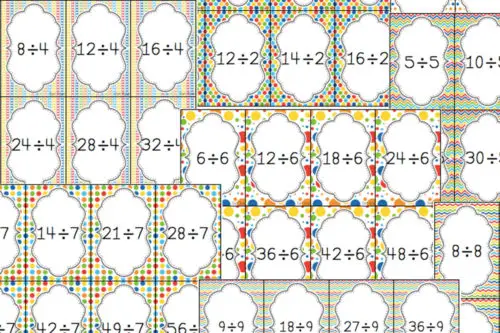
This game uses the standard “war” game rule. You get cards with divisions (“27÷3” for example) and cards with numbers (“6” for instance). The interesting thing with this printable is that there are 15 different sets of cards, which enables to cover all the division facts and gives many options. I would recommend for math stations or even at home (but you do have to print, cut the cards, laminate).
uses the standard “war” game rule. You get cards with divisions (“27÷3” for example) and cards with numbers (“6” for instance). The interesting thing with this printable is that there are 15 different sets of cards, which enables to cover all the division facts and gives many options. I would recommend for math stations or even at home (but you do have to print, cut the cards, laminate).
Goofy Gorilla and Other Similar Games
- Goofy Gorilla
 is also the same “matching” type of game, but with large numbers that enable to practice division patterns with Multiples of 10, which is great!… and it features gorillas as a theme… and has a special card for playing Old Maid.
is also the same “matching” type of game, but with large numbers that enable to practice division patterns with Multiples of 10, which is great!… and it features gorillas as a theme… and has a special card for playing Old Maid. - Go Divide
 (Stephanie Melvin) has similar cards, except that the cards are meant to play “Go Fish”.
(Stephanie Melvin) has similar cards, except that the cards are meant to play “Go Fish”. - Math-O
 cards are UNO-themed cards with divisions (“27÷3” for example) and cards with numbers (“6” for instance), plus some special cards taken from UNO. Color and blackline versions are included. You can play basic math facts (not all math facts, just 36 per deck, which is disappointing in my opinion).
cards are UNO-themed cards with divisions (“27÷3” for example) and cards with numbers (“6” for instance), plus some special cards taken from UNO. Color and blackline versions are included. You can play basic math facts (not all math facts, just 36 per deck, which is disappointing in my opinion). - Monster Quotients
 is another similar game (but with a slightly different rule), themed with monsters. The monsters are cute. But the 52 cards do not cover all division facts 1-12.
is another similar game (but with a slightly different rule), themed with monsters. The monsters are cute. But the 52 cards do not cover all division facts 1-12. - Hot Pepper Division
 is another similar “matching” game themed with peppers. The peppers are cute and spice up the game. All facts 1-12 ar covered.
is another similar “matching” game themed with peppers. The peppers are cute and spice up the game. All facts 1-12 ar covered.
These 6 games can be used to pay “War”, “Go Fish” or a “Memory” game with divisions. I personally recommend:
- Division facts war for small divisions because :
- The form factor of the cards (taller than wide) makes them easier to manipulate.
- It does not infringe copyright (though I admit UNO theme is tempting for children).
- It covers all division facts 1-12.
- Goofy Gorilla because it enables to make divisions of large numbers that are multiples of 10.
Here is my big tip: “Division facts war” and “Goofy Gorilla” can be used to play “Old Maid” (also called “Odd One Out”). As users have to keep cards in their hands, the vertical layout is essential for this rule. Remark: To do this with “Division facts war”, you will have to create a special card (the one being the only remaining in the end).
Why this is important: in my experience “Old Maid” is the most fun of the 4 classical rules (and it is perfectly driven by chance like “war”). My preference among the 4 rules (for 4th/5th grade) is: “Old Maid” > “War” >> “Go Fish” & “Memory”.
Boom!
In Boom !, students draw cards with divisions written on them and must give the correct result to keep the cards. If they draw a “boom” card, they lose their cards. The game is good for school use as “boom” cards give players more or less equal chances to win.
!, students draw cards with divisions written on them and must give the correct result to keep the cards. If they draw a “boom” card, they lose their cards. The game is good for school use as “boom” cards give players more or less equal chances to win.
All division facts 1-12 are included, which is nice too.
Harry Potter Themed Card & Board Game
The first rule (revenge) is similar to the (“Boom!) game before, except that the cards are themed after Harry Potter, and that there are also special cards and task cards. There is a second rule where you make a board game. You also can use the cards as a scoot activity.
is similar to the (“Boom!) game before, except that the cards are themed after Harry Potter, and that there are also special cards and task cards. There is a second rule where you make a board game. You also can use the cards as a scoot activity.
I would personally rather use “Boom!” because it does not infringe copyright, but Harry Potter is sure to be an easy sell with children, so it is tempting :-).
Edudingo.com is a participant in the Amazon Services LLC Associates Program, an affiliate advertising program designed to provide a means for sites to earn advertising fees by advertising and linking to Amazon.com. We also participate in other affiliate programs which compensate us for referring traffic.

